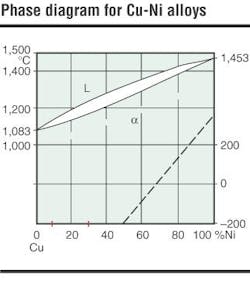Copper-nickel alloy improves protection against corrosion and biofouling
Since the 1980s, Osnabruck-based KME has provided materials for various systems for handling of seawater on offshore installations, mainly for fire main lines and cooling systems, via OSNA 10, its version of the copper-nickel alloy Cu-Ni 90/10. Recent deliveries included Mad Dog and White Rose in North America, Kizomba B and Sanha offshore Angola, and the South Pars projects off Iran.
Projects in progress include 230 tonnes of copper-nickel for the main processing platform for EnCana's Buzzard platform in the UK North Sea, and a consignment for ExxonMobil's Erha installation offshore Nigeria. KME's largest delivery to an offshore unit was the 700-tonne copper-nickel job supplied to BP's Thunder Horse semisubmersible. This order came from DSME working as a subcontractor for the engineering project management company Mustang Engineering Houston.
Recent research
KME has performed extensive studies on biofouling and associated containment issues with the University of Hamburg. Biofouling of platform pipe work can be costly rectify, due to the corrosion behavior of stainless steels and seawater chlorination. The problem can be more acute in warm climates, which promote more rapid growth of marine organisms on exposed surfaces. This is a concern for operators planning large-scale investments in emerging regions such as West Africa, South America, and Far and Middle East.
Due to the metabolism of organisms within the biofilm, the corrosion performance of many materials is significantly deteriorated. However, OSNA 10 resists this process, due to the inherent gradual release of copper ions that are not tolerated by marine organisms. This in turn retards formation of a bacterial layer on the exposed surface. Cupronickel generates a passive multi-layered film, but the thin cuprous oxide layer, extending to the bulk metal, provides adequate corrosion resistance. The upper layers limit the release of copper ions to seawater so that even if organism settlement does occur (on the surface), the impact is negligible, and the settlement can be easily be sloughed off. This renders intensive pipe cleaning or seawater chlorination unnecessary, allowing a signification reduction in maintenance costs.
In cooperation with various research institutions, a new two-and-half year study is about to embark. The aim of this project, funded by the German government, is to determine a method of creating a quick-forming, corrosion-protective layer on inner pipe surfaces, to counter damage caused by ingress of contaminated seawater.
Wilhelm Schleich of KME's technical customer service division says: "OSNA 10 offers numerous advantages in application. Cu-Ni alloys maintain a single phase, face-centered cubic structure. As with austenitic stainless steels, this provides good ductility and impact strength at all temperatures experienced under offshore conditions. In addition, the absence of phase transformations during thermal cycles limits the impact of welding on the material's mechanical characteristics and corrosion resistance."
When exposed to natural or normally chlorinated seawater, cupronickel reveals a high resistance to localized corrosion within a broad range of ambient temperatures that is lacking among standard stainless steels or even super alloys. Due to the alloy's resistance to biofouling, potential sites for pitting attack are limited, also in applications subjected to slowly moving seawater. If pitting does occur, long-term tests have shown that the average depth of penetration does not propagate over time, as is the case with stainless steels.
"In discussion with our clients, the properties of copper-nickel are often compared with super-duplex and glass fiber reinforced materials (GFRP), which are competing materials for seawater applications," says Klaus Steinkamp, KME's sales manager for seawater applications. "In contrast to material from some other manufacturers, the chemical composition of OSNA 10 has been optimized by KME during the last few decades. Many of our customers appreciate the installation properties of our alloy such as mechanical ductility and weld-ability. In contrast to GFRP, the severe offshore conditions do not deteriorate the mechanical integrity of CuNi piping, which can be an appreciable safety concern particular to these applications.
"Lately, we have staged seminars for Petrobras engineers," he adds. "Petrobras began to specify the cupronickel in 1973, and its is of the few of companies possessing very clear rules about using this alloy. Other super-majors seldom seem to have precise in-house guidelines. In my opinion, it is because these companies have different engineering centers at different international locations, which are allowed to steer their own individual course.
"Understanding of the material's advantages should be better – to this end, we can provide any type of technical support. Unfortunately, some oil companies do not realize that the available piping dimensions and flow characteristics of CuNi at applied pressure rates make these alloy very easy to work with providing considerable advantages from economical perspective."

